

高等学校化学学报 ›› 2023, Vol. 44 ›› Issue (9): 20230150.doi: 10.7503/cjcu20230150
收稿日期:2023-03-30
出版日期:2023-09-10
发布日期:2023-06-08
通讯作者:
谭占鳌
E-mail:tanzhanao@mail.buct.edu.cn
基金资助:
WANG Jiarui, YU Runnan, TAN Zhan’ao( )
)
Received:2023-03-30
Online:2023-09-10
Published:2023-06-08
Contact:
TAN Zhan’ao
E-mail:tanzhanao@mail.buct.edu.cn
Supported by:摘要:
有机太阳电池因具有质量轻、 色彩丰富及可制备柔性大面积器件等优势而备受关注. 开发高性能的活性层给、 受体材料及界面层材料是提升有机太阳电池光电性能的关键. 金属配合物兼具金属配位的自组装有序性和有机分子的结构多样性, 且具有较高的三线态激子密度和较长的激子寿命, 是一类重要的光电功能材料. 随着对不同金属配合物光电性质的不断研究, 越来越多的金属配合物光电材料被应用于有机太阳电池中, 并获得了较高的器件光电性能. 本文综述了基于铂、 锌、 铱、 钌、 锆等金属的配合物在有机太阳电池活性层、 界面层及添加剂中的应用, 并对其结构-性能关系进行了深入分析, 最后对这类材料面临的挑战与机遇进行了展望, 以便为高性能金属配合物材料的设计及其在有机太阳电池中的应用提供参考与启发.
中图分类号:
TrendMD:
王嘉睿, 于润楠, 谭占鳌. 金属配合物在有机太阳电池中的应用进展. 高等学校化学学报, 2023, 44(9): 20230150.
WANG Jiarui, YU Runnan, TAN Zhan’ao. Recent Advances in the Application of Metal Complexes for Organic Solar Cells. Chem. J. Chinese Universities, 2023, 44(9): 20230150.
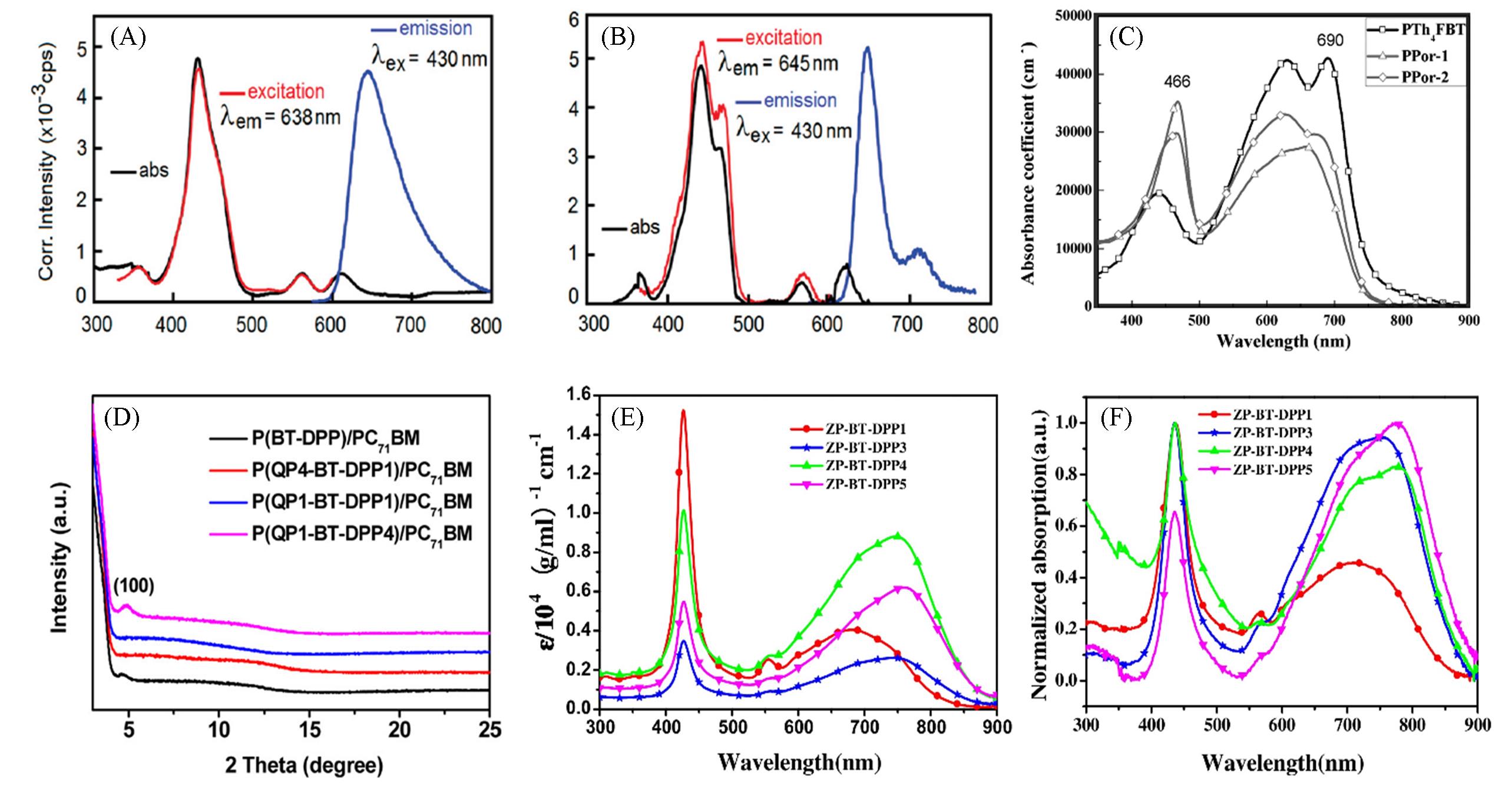
Fig.2 Absorption(black), excitation(red) and fluorescence(blue) spectra of ZP11 in 2⁃MeTHF at 298(A) and 77 K[12](B), UV⁃Vis absorption spectra of ZP12 and ZP13 thin films[7](C), XRD patterns of ZP14—ZP16/PC71BM(1∶2, mass ratio) blend films[8](D), UV⁃Vis absorption spectra of copolymers ZP21 in chloroform solution(D) and in thin films(F)[10](A, B) Copyright 2011, Amercian Chemical Society; (C) Copyright 2014, Wiley‐VCH Verlag GmbH & Co. KGaA, Weinheim; (D) Copyright 2015, Amercian Chemical Society; (E, F) Copyright 2016, Elsevier B.V.
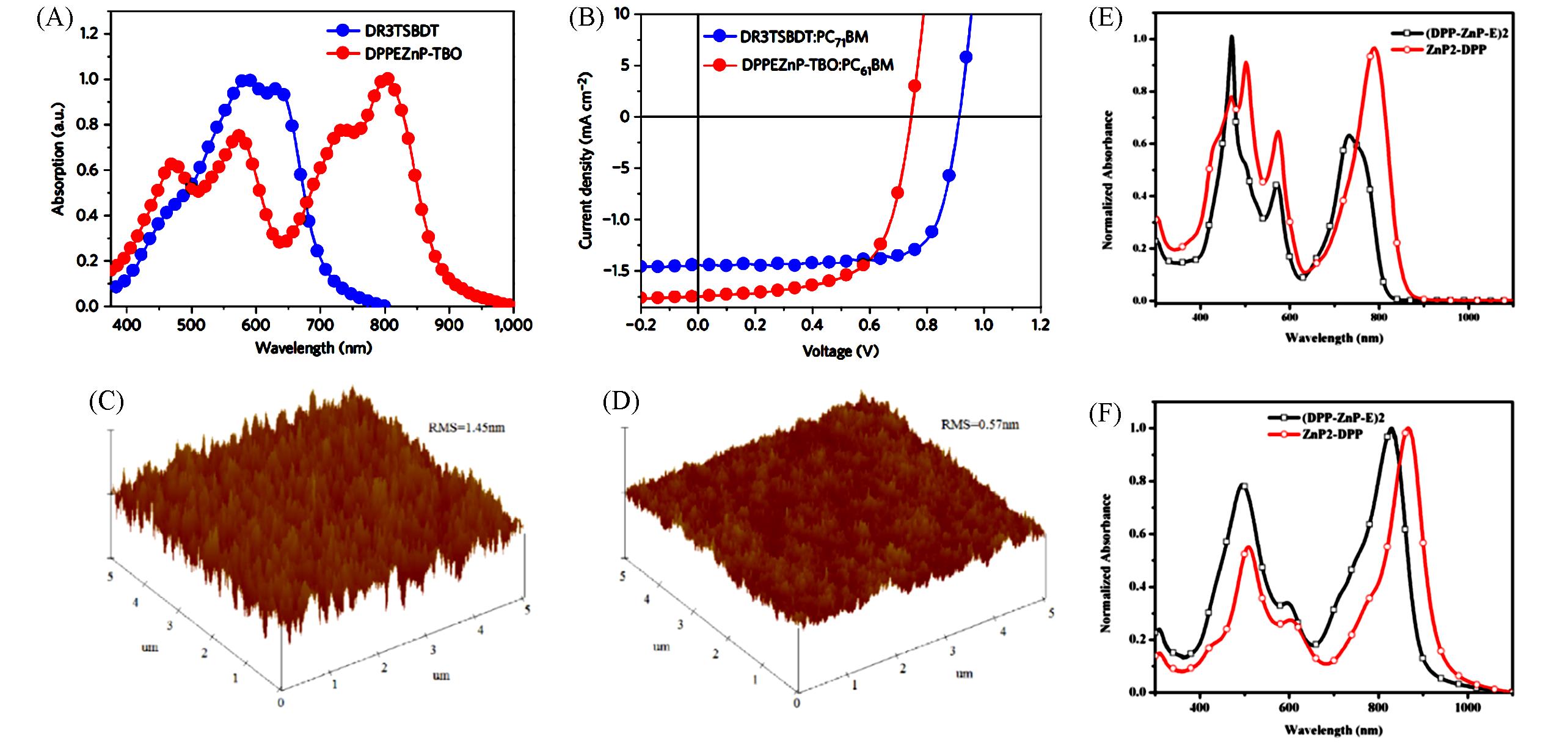
Fig.5 Photovoltaic performance of the single⁃junction devices for ZS9[18](A, B), AFM height images and AFM images of ZS16/PC71BM(1∶1) composite film prepared without and with 3% pyridine[22], respectively(C, D), UV⁃Vis⁃NIR absorption spectra of ZS31 in THF solution(E) and thin film(F)[28](A, B) Copyright 2016, Nature Publishing Group; (C, D) Copyright 2015, the Royal Society of Chemistry; (E, F) Copyright 2018, American Chemical Society.
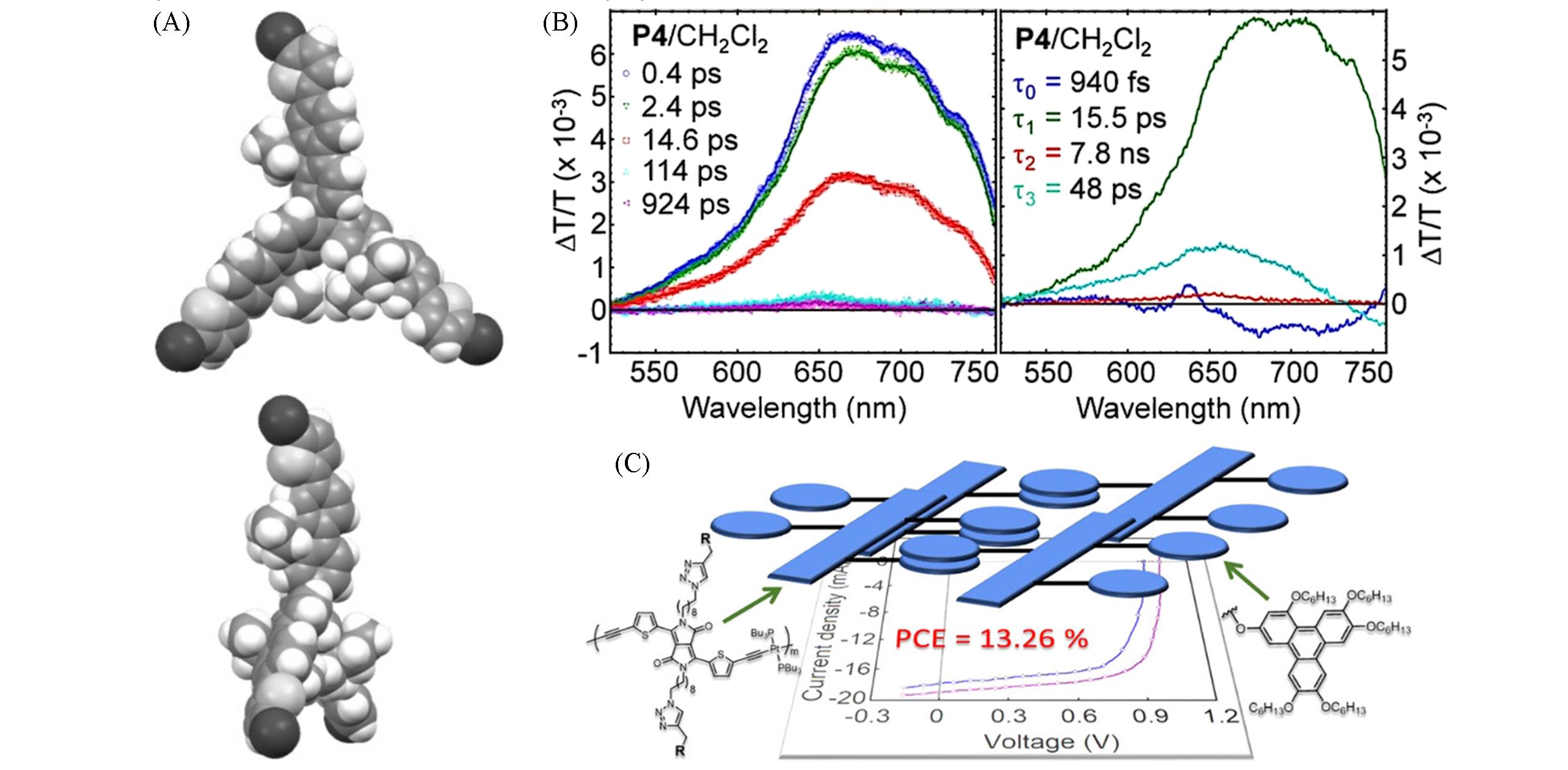
Fig.8 Space filling model: top view(top) and side⁃view(bottom) of PP41[50](A), time⁃evolution of the fs⁃TAS spectra of PP48(left) and decay associated spectra stressing on the various transient species of PP48(right)[52], simulation of the self⁃assembled structure of the PP51 molecule[53](C)(A) Copyright 2011, Wiley‐VCH Verlag GmbH & Co. KGaA, Weinheim; (B) Copyright 2020, the Royal Society of Chemistry; (C) Copyright 2021, American Chemical Society.

Fig.12 Absorption spectra of PS1—PS3 thin films after annealing at 70 ℃ for 30 min[57](A) and structure and photovoltaic performance of PS12[61](B)(A) Copyright 2010, American Chemical Society; (B) Copyright 2017, American Chemical Society.
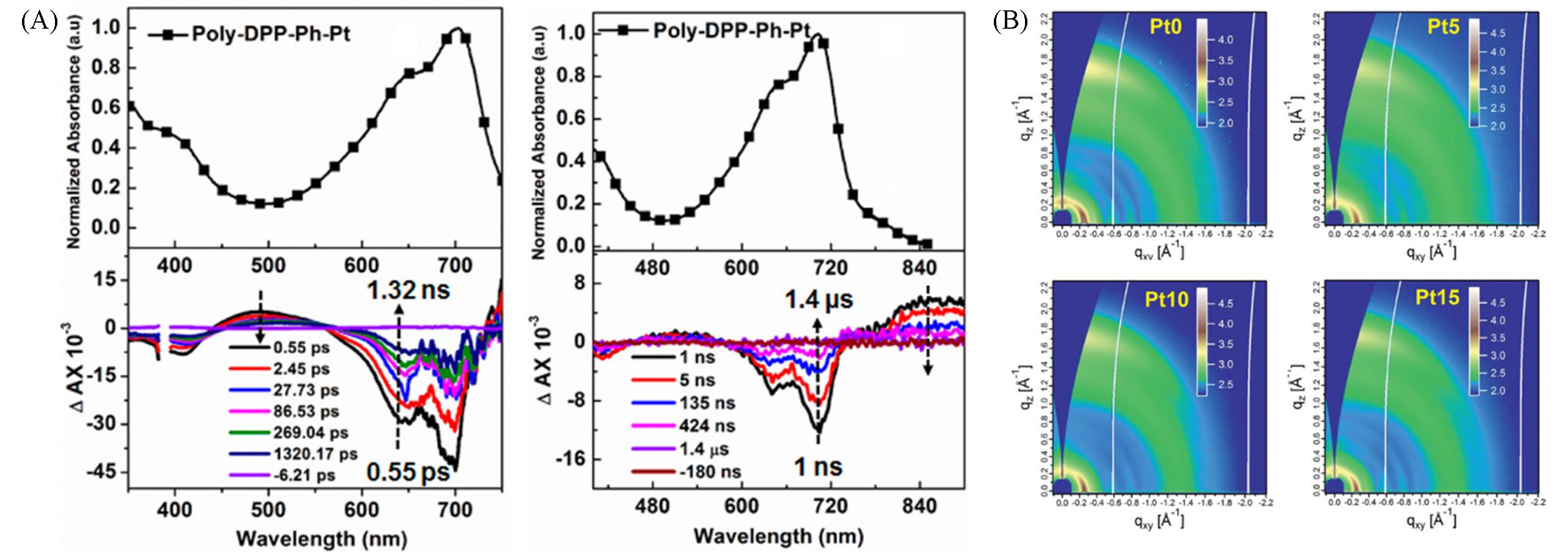
Fig.14 Picosecond(left) and nanosecond(right) transient absorption spectra of CP7(steady⁃state absorption spectra for both polymers)[65](A) and 2D⁃GIWAXS patterns of the polymers CP13⁃n[69](B)(A) Copyright 2017, American Chemical Society; (B) Copyright 2019, Wiley‐VCH Verlag GmbH & Co. KGaA, Weinheim.
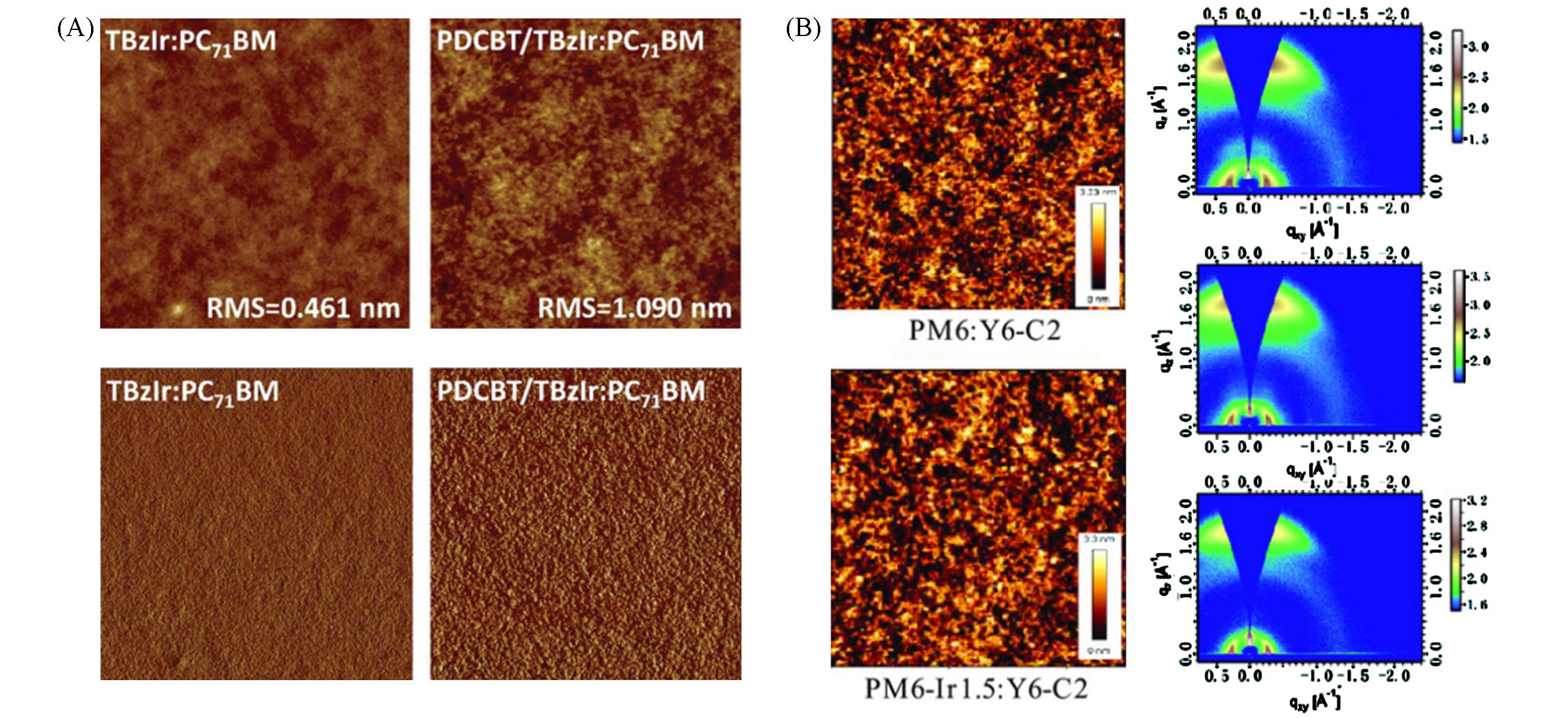
Fig.16 AFM height images and phase images of IrD8∶PC71BM and PDCBT/IrD8∶PC71BM[78](A) and AFM topography images of the photoactive layer films for PM6∶Y6⁃C2(top) and IrP3⁃1.5∶Y6⁃C2(bottom), the 2D GIWAXS profiles for the pristine Y6⁃C2 film(top), blend PM6∶Y6⁃C2 film(middle), and blend IrP3⁃1.5∶Y6⁃C2 film(bottom)[82](B)(A) Copyright 2019, the Royal Society of Chemistry; (B) Copyright2020, Wiley‐VCH Verlag GmbH & Co. KGaA, Weinheim.
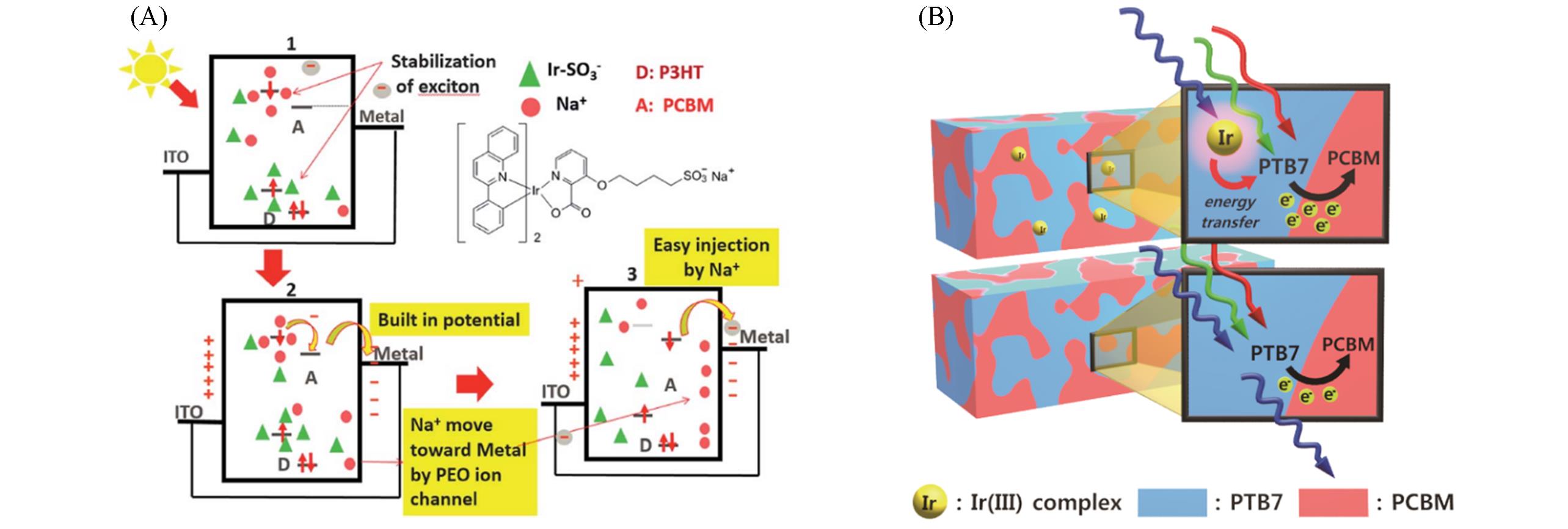
Fig.20 Plausible mechanism of the PEO ion channel in P3HT and PCBM with IrA2 and PEO[88](A) and schematic of energy transfer from an Ir(III) complex to PTB7∶PCBM[89](B)(A) Copyright 2014, the Royal Society of Chemistry; (B) Copyright 2016, American Chemical Society.
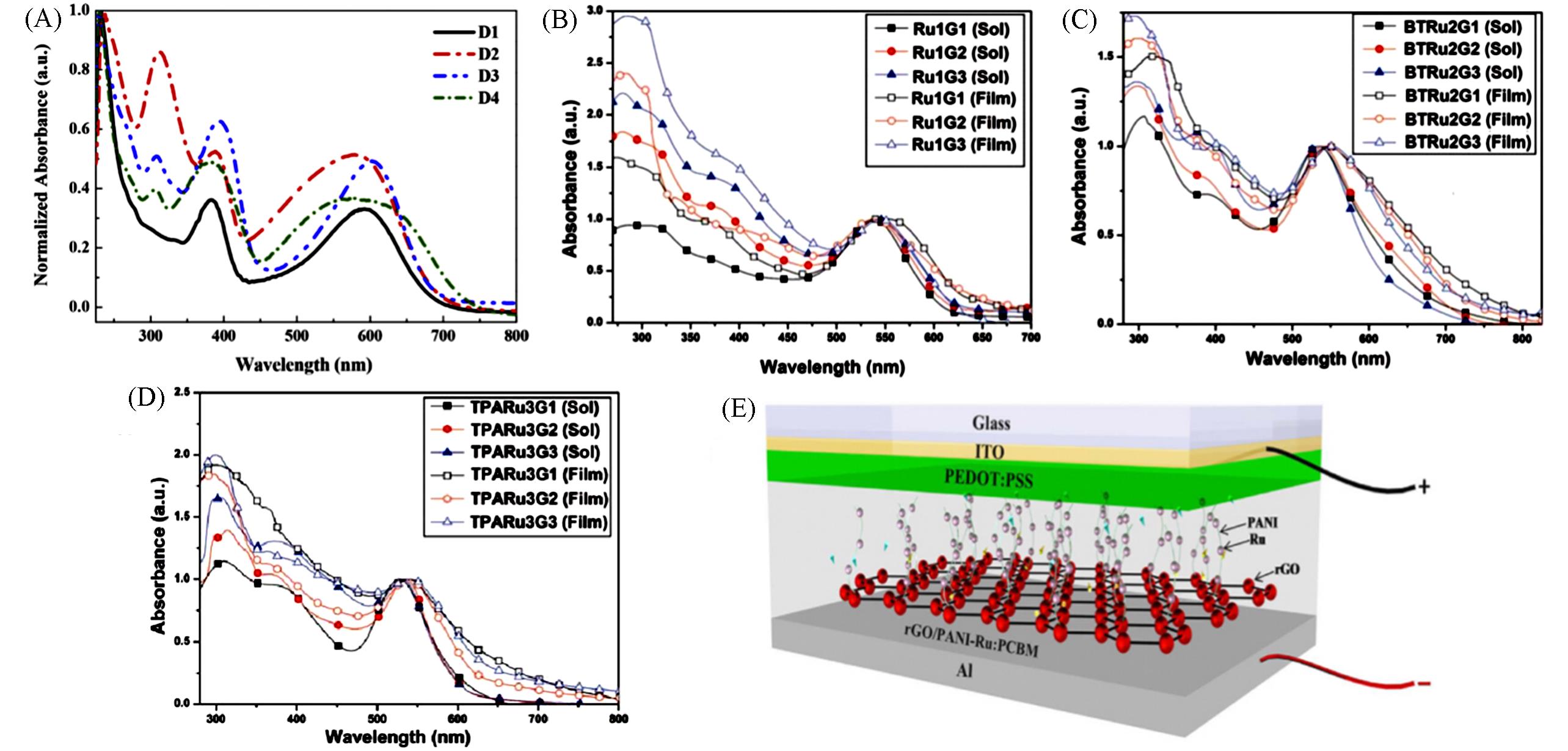
Fig.21 Normalized absorption spectra of RP2⁃5 in CH2Cl2 at 298 K[92](A), UV⁃Vis absorption spectra of the mono⁃Ru⁃based(B), bis⁃Ru⁃based(C) and tris⁃Ru⁃based(D) systems in CHCl3 and solid films[94] and schematic diagram of PSC device fabricated using rGO/RP19 as an electron donor[96](E)(A) Copyright 2017, Elsevier B. V; (B—D) Copyright 2017, Elsevier B. V; (E) Copyright 2017, the authors.
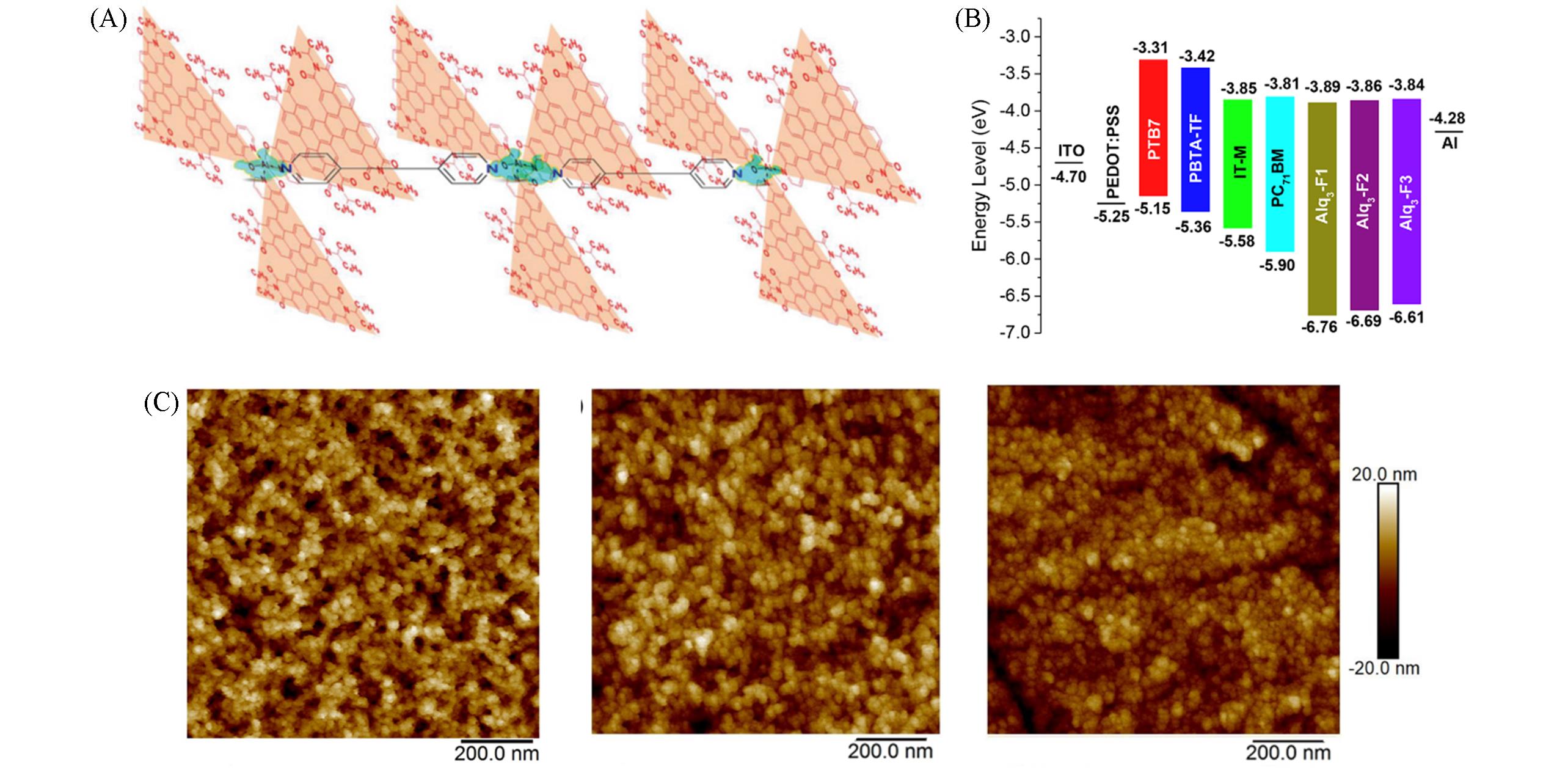
Fig.23 Schematic illustration of the molecular lock effect between Bipy and the Alq3 core for Alq3⁃PID2[97](A), energy level diagram of Alq3⁃F1—Alq3⁃F3 used in this work for fabricating PSCs[99](B), AFM height images of the TiAA films with the following annealing temperatures: low temperature(75 ℃, left), medium temperature(125 ℃, middle), and high temperature(200 ℃, right)[103](C)(A) Copyright 2019, Wiley-VCH Verlag GmbH & Co. KGaA; (B) Copyright 2018, Wiley-VCH Verlag GmbH & Co. KGaA, Weinheim; (C) Copyright 2019, American Chemical Society.
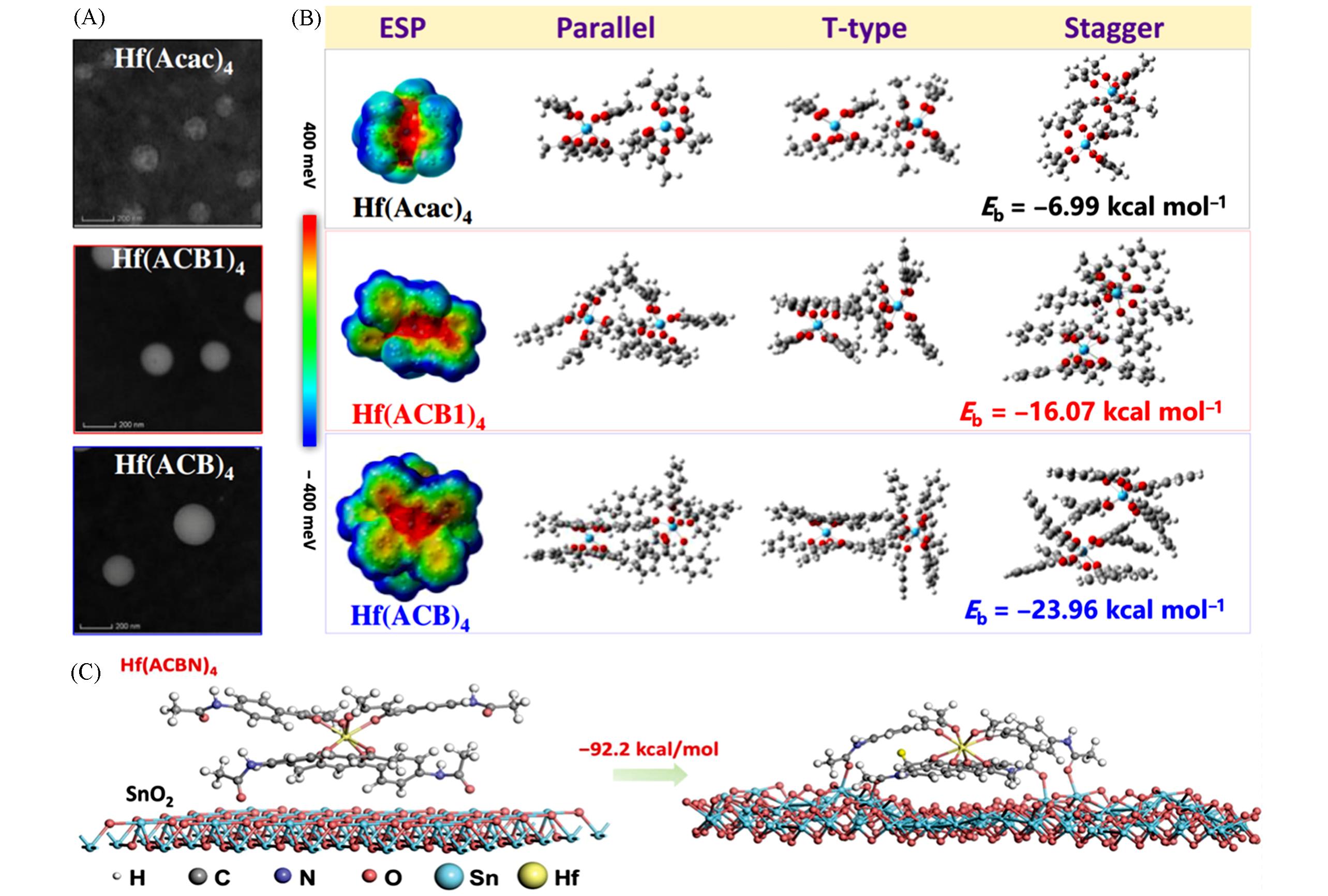
Fig.24 Plane⁃view TEM images of the spin⁃coated films of Hf(Acac)4, Hf(ACB1)4, Hf(ACB)4(A), ESP maps and the modeled bimolecular aggregation configurations of the three chelates[105](B) and initial and optimized configurations of SnO2/Hf(ACBN)4 with the corresponding binding energy values[106](C)(A, B) Copyright 2021, Chinese Chemical Society; (C) Copyright 2022, Wiley‐VCH GmbH.
| 1 | Zhu L., Zhang M., Xu J., Li C., Yan J., Zhou G., Zhong W., Hao T., Song J., Xue X., Zhou Z., Zeng R., Zhu H., Chen C. C., MacKenzie R. C. I., Zou Y., Nelson J., Zhang Y., Sun Y., Liu F., Nat. Mater., 2022, 21(6), 656—663 |
| 2 | Huang X. B., Zhu C. L., Zhang S. M., Li W. W., Guo Y. L., Zhan X. W., Liu Y. Q., Bo Z. S., Macromolecules, 2008, 41(19), 6895—6902 |
| 3 | Xiang N., Liu Y., Zhou W., Huang H., Guo X., Tan Z., Zhao B., Shen P., Tan S., Eur. Polym. J., 2010, 46(5), 1084—1092 |
| 4 | Liu Y., Guo X., Xiang N., Zhao B., Huang H., Li H., Shen P., Tan S., J. Mater. Chem., 2010, 20(6), 1140—1146 |
| 5 | Lee J. Y., Song H. J., Lee S. M., Lee J. H., Moon D. K., Eur. Polym. J., 2011, 47(8), 1686—1693 |
| 6 | Zhan H., Lamare S., Ng A., Kenny T., Guernon H., Chan W. K., Djurišić A. B., Harvey P. D., Wong W. Y., Macromolecules, 2011, 44(13), 5155—5167 |
| 7 | Chao Y. H., Jheng J. F., Wu J. S., Wu K. Y., Peng H. H., Tsai M. C., Wang C. L., Hsiao Y. N., Wang C. L., Lin C. Y., Hsu C. S., Adv. Mater., 2014, 26(30), 5205—5210 |
| 8 | Wang L., Shi S., Ma D., Chen S., Gao C., Wang M., Shi K., Li Y., Li X., Wang H., Macromolecules, 2014, 48(1), 287—296 |
| 9 | Wang L., Qiao Z., Gao C., Liu J., Zhang Z. G., Li X., Li Y., Wang H., Macromolecules, 2016, 49(10), 3723—3732 |
| 10 | Luo X., Wu F., Xiao H., Guo H., Liu Y., Tan S., Synth. Met., 2017, 223(2017), 205—211 |
| 11 | Bucher L., Tanguy L., Desbois N., Karsenti P. L., Harvey P. D., Gros C. P., Sharma G. D., Sol. RRL, 2018, 2(1), 1700168 |
| 12 | Sharma G. D., Daphnomili D., Biswas S., Coutsolelos A. G., Org. Electron., 2013, 14(7), 1811—1819 |
| 13 | Huang Y., Li L., Peng X., Peng J., Cao Y., J. Mater. Chem., 2012, 22(41), 21841—21844 |
| 14 | Li L., Huang Y., Peng J., Cao Y., Peng X., J. Mater. Chem. A, 2013, 1(6), 2144—2150 |
| 15 | Xiao L., Liu C., Gao K., Yan Y., Peng J., Cao Y., Peng X., RSC Adv., 2015, 5(112), 92312—92317 |
| 16 | Liang T., Xiao L., Liu C., Gao K., Qin H., Cao Y., Peng X., Org. Electron., 2016, 29, 127—134 |
| 17 | Gao K., Miao J., Xiao L., Deng W., Kan Y., Liang T., Wang C., Huang F., Peng J., Cao Y., Liu F., Russell T. P., Wu H., Peng X., Adv. Mater., 2016, 28(23), 4727—4733 |
| 18 | Li M., Gao K., Wan X., Zhang Q., Kan B., Xia R., Liu F., Yang X., Feng H., Ni W., Wang Y., Peng J., Zhang H., Liang Z., Yip H. L., Peng X., Cao Y., Chen Y., Nat. Photonics., 2016, 11(2), 85—90 |
| 19 | Cuesta V., Vartanian M., Pilar D. L. C., Singhal R., Sharma G. D., Langa F., J. Mater. Chem. A, 2017, 5(3), 1057—1065 |
| 20 | Liang T., Xiao L., Gao K., Xu W., Peng X., Cao Y., ACS Appl. Mater. Interfaces, 2017, 9(8), 7131—7138 |
| 21 | Montcada N. F., Arrechea S., Molina—Ontoria A., Aljarilla A. I., de la Cruz P., Echegoyen L., Palomares E., Langa F., Org. Electron., 2016, 38, 330—336 |
| 22 | Chen S., Xiao L., Zhu X., Peng X., Wong W. K., Wong W. Y., Chem. Commun., 2015, 51(77), 14439—14442 |
| 23 | Chen S., Yan L., Xiao L., Gao K., Tang W., Wang C., Zhu C., Wang X., Liu F., Peng X., Wong W. K., Zhu X., J. Mater. Chem. A, 2017, 5(48), 25460—25468 |
| 24 | Aljarilla S. A. A., Pilar D. L. C., Palomares E., Sharma D. G., Langa E., Nanoscale, 2016, 8(41), 17953 — 17962 |
| 25 | Xiao L., Chen S., Gao K., Peng X., Liu F., Cao Y., Wong W. Y., Wong W. K., Zhu X., ACS Appl. Mater. Interfaces, 2016, 8(44), 30176—30183 |
| 26 | Aljarilla S. A. A., Cruz P. d. l., Singh M. K., Sharma G. D., Langa F., J. Mater. Chem. C, 2017, 5(19), 4742 — 4751 |
| 27 | Lai T., Chen X., Xiao L., Zhang L., Liang T., Peng X., Cao Y., Chem. Commun. 2017, 53(37), 5113—5116 |
| 28 | Lai T., Xiao L., Deng K., Liang T., Chen X., Peng X., Cao Y., ACS Appl. Mater. Interfaces, 2018, 10(1), 668—675 |
| 29 | Zhang A., Li C., Yang F., Zhang J., Wang Z., Wei Z., Li W., Angew. Chem., Int. Ed., 2017, 56(10), 2694—2698 |
| 30 | Hadmojo W. T., Yim D., Aqoma H., Ryu D. Y., Shin T. J., Kim H. W., Hwang E., Jang W. D., Jung I. H., Jang S. Y., Chem. Sci., 2017, 8(7), 5095—5100 |
| 31 | Guo Y., Zhang A., Li C., Li W., Zhu D., Chin. Chem. Lett., 2018, 29(3), 371—373 |
| 32 | Pan X., Huang S., Zhu B., Xia R., Peng X., Dyes. Pigm., 2020, 180(2020), 108503 |
| 33 | Köhler A., Wittmann H. F., Friend R. H., Khan M. S., Lewis J., Synth. Met., 1996, 77, 147—150 |
| 34 | Chawdhury N., Köhler A., Friend R. H., Wong W. Y., Lewis J., Younus M., Raithby P. R., Corcoran T. C., Al⁃Mandhary M. R. A., Khan M. S., J. Chem. Phys., 1999, 110(10), 4963—4970 |
| 35 | Guo F., Kim Y. G., Reynolds J. R., Schanze K. S., Chem. Commun., 2006, 17, 1887—1889 |
| 36 | Wong W. Y., Wang X. Z., He Z., Djurisic A. B., Yip C. T., Cheung K. Y., Wang H., Mak C. S., Chan W. K., Nat. Mater., 2007, 6(7), 521—527 |
| 37 | Wong W. Y., Wang X., Zhang H. L., Cheung K. Y., Fung M. K., Djurišić A. B., Chan W. K., J. Organomet. Chem., 2008, 693(24), 3603—3612 |
| 38 | Baek N. S., Hau S. K., Yip H. L., Acton O., Chen K. S., Jen A. K. Y., Chem. Mater., 2008, 20, 5734—5736 |
| 39 | Wang Q., Wong W. Y., Polym. Chem., 2011, 2(2), 432—440 |
| 40 | Wu. P. T., Bull. T., Kim. F. S., Luscombe. C. K., Jenekhe. S. A., Macromolecules, 2009, 42, 671—681 |
| 41 | Wang X. Z., Ho C. L., Yan L., Chen X., Chen X., Cheung K. Y., Wong W. Y., J. Inorg. Organomet. Polym. Mater., 2010, 20(3), 478—487 |
| 42 | Liu Q., Ho C. L., Lo Y. H., Li H., Wong W. Y., J. Inorg. Organomet. Polym. Mater., 2014, 25(1), 159—168 |
| 43 | Qin C., Fu Y., Chui C. H., Kan C. W., Xie Z., Wang L., Wong W. Y., Macromol. Rapid. Commun., 2011, 32(18), 1472—1477 |
| 44 | Wong W. Y., Wang X. Z., He Z., Chan K. K., Djurišić A. B., Cheung K. Y., Yip C. T., Ng A. M. C., Xi Y. Y., Mak C. S. K., Chan W. K., J. Am. Chem. Soc., 2007, 129(46), 14372—14380 |
| 45 | Liu L., Ho C. L., Wong W. Y., Cheung K. Y., Fung M. K., Lam W. T., Djurišić A. B., Chan W. K., Adv. Func. Mater., 2008, 18(18), 2824—2833 |
| 46 | Wong W. Y., Chow W. C., Cheung K. Y., Fung M. K., Djurišić A. B., Chan W. K., J. Organomet. Chem., 2009, 694(17), 2717—2726 |
| 47 | Wang X. Z., Wang Q., Yan L., Wong W. Y., Cheung K. Y., Ng A., Djurisic A. B., Chan W. K., Macromol. Rapid. Commun., 2010, 31(9/10), 861—867 |
| 48 | Zhan H., Wong W. Y., Ng A., Djurišić A. B., Chan W. K., J. Organomet. Chem., 2011, 696(25), 4112—4120 |
| 49 | Li L., Chow W. C., Wong W. Y., Chui C. H., Wong R. S. M., J. Organomet. Chem., 2011, 696(6), 1189—1197 |
| 50 | Wang Q., He Z., Wild A., Wu H., Cao Y., U S. S., Chui C. H., Wong W. Y., J. Chem. Asian, 2011, 6(7), 1766—1777 |
| 51 | Wu P. T., Bull T., Kim F. S., Luscombe C. K., Jenekhe S. A., Macromolecules, 2009, 42(2009), 671—681 |
| 52 | Nos M., Marineau⁃Plante G., Gao D., Durandetti M., Hardouin J., Karsenti P. L., Gupta G., Sharma G. D., Harvey P. D., Lemouchi C., Le Pluart L., J. Mater. Chem. C, 2020, 8(7), 2363—2380 |
| 53 | Marineau⁃Plante G., Nos M., Gao D., Durandetti M., Hardouin J., Karsenti P. L., Lemouchi C., Le Pluart L., Sharma G. D., Harvey P. D., ACS Appl. Polym. Mater., 2021, 3(2), 1087—1096 |
| 54 | Takahashi S., Morimoto H., Takai Y., Sonogashira K., Hagihara N., Mol. Cryst. Liq. Cryst., 2007, 72(2/3), 101—105 |
| 55 | Yuan Y., Michinobu T., Macromol. Chem. Phys., 2012, 213(20), 2114—2119 |
| 56 | Yuan Y., Michinobu T., Oguma J., Kato T., Miyake K., Macromol. Chem. Phys., 2013, 214(13), 1465—1472 |
| 57 | Zhao X., Piliego C., Kim B., Poulsen D. A., Ma B., Unruh D. A., Fréchet J. M. J., Chem. Mater., 2010, 22(7), 2325—2332 |
| 58 | Cui C., Zhang Y., Choy W. C. H., Li H., Wong W. Y., Sci. China: Chem., 2015, 58(2), 347—356 |
| 59 | Dai F. R., Zhan H. M., Liu Q., Fu Y. Y., Li J. H., Wang Q. W., Xie Z., Wang L., Yan F., Wong W. Y., Chem., 2012, 18(5), 1502—1511 |
| 60 | He W., Livshits M. Y., Dickie D. A., Yang J., Quinnett R., Rack J. J., Wu Q., Qin Y., Chem. Sci., 2016, 7(9), 5798—5804 |
| 61 | He W., Livshits M. Y., Dickie D. A., Zhang Z., Mejiaortega L. E., Rack J. J., Wu Q., Qin Y., J. Am. Chem. Soc., 2017, 139(40), 14109—14119 |
| 62 | Clem T. A., Kavulak D. F. J., Westling E. J., Fréchet J. M. J., Chem. Mater., 2009, 22(6), 1977—1987 |
| 63 | Liao C. Y., Chen C. P., Chang C. C., Hwang G. W., Chou H. H., Cheng C. H., Sol. Energy Mater. Sol. Cells, 2013, 109, 111—119 |
| 64 | Goswami S., Gish M. K., Wang J., Winkel R. W., Papanikolas J. M., Schanze K. S., ACS Appl. Mater. Interfaces, 2015, 7(48), 26828—26838 |
| 65 | Goswami S., Hernandez J. L., Gish M. K., Wang J., Kim B., Laudari A. P., Guha S., Papanikolas J. M., Reynolds J. R., Schanze K. S., Chem. Mater., 2017, 29(19), 8449—8461 |
| 66 | Holt E. D., Wang J., Winkel R. W., Younus M., Schanze K. S., J. Photochem. Photobiol., 2021, 8(2021), 100060 |
| 67 | Goswami S., Winkel R. W., Alarousu E., Ghiviriga I., Mohammed O. F., Schanze K. S., J. Phys. Chem. A, 2014, 118(50), 11735—11743 |
| 68 | Wan Z., Yang J., Liu Y., Wang S., Zhong Y., Li C., Zhang Z., Xing G., Huettner S., Tao Y., Li Y., Huang W., Polym. Chem., 2017, 8(32), 4729—4737 |
| 69 | Xu X., Feng K., Bi Z., Ma W., Zhang G., Peng Q., Adv. Mater., 2019, 31(29), 1901872 |
| 70 | Gao X., Wang M., Cao X., Yang J., Zhong Y., Zhang Z., Li C., Huettner S., Tao Y., Li Y., Huang W., J. Polym. Sci, Part A: Polym. Chem., 2018, 56(1), 105—115 |
| 71 | Gao X., Shi D., Wang M., Xue Z., Hu Y., Tao Y., Huang W., J. Mater. Chem. C, 2018, 6(37), 9903—9913 |
| 72 | Gao X., Liang Y., Wang H., Yang T., Huettner S., Wang J., Zhu F., Tao Y., Org. Electron., 2019, 70(2019), 93—100 |
| 73 | Schulz G. L., Holdcroft S., Chem. Mater., 2008, 20, 5351—5355 |
| 74 | Yu J., Zang Y., Li H., Huang J., Thin Solid Films, 2012, 520(21), 6653—6657 |
| 75 | Fleetham T. B., Wang Z., Li J., Inorg. Chem., 2013, 52(13), 7338—7343 |
| 76 | Zhen H., Hou Q., Li K., Ma Z., Fabiano S., Gao F., Zhang F., J. Mater. Chem. A, 2014, 2(31), 12390—12396 |
| 77 | Jin Y., Xue J., Qiao J., Zhang F., J. Mater. Chem. C, 2019, 7(47), 15049—15056 |
| 78 | Wu Q., Cheng Y., Xue Z., Gao X., Wang M., Yuan W., Huettner S., Wan S., Cao X., Tao Y., Huang W., Chem. Commun., 2019, 55(18), 2640—2643 |
| 79 | Yang T., Gao X., He Y., Wang H., Tao Y., J. Mater. Chem. C, 2020, 8(17), 5761—5768 |
| 80 | Qian M., Zhang R., Hao J., Zhang W., Zhang Q., Wang J., Tao Y., Chen S., Fang J., Huang W., Adv. Mater., 2015, 27(23), 3546—3552 |
| 81 | Xue Z., Wang S., Yang J., Zhong Y., Qian M., Li C., Zhang Z., Xing G., Huettner S., Tao Y., Li Y., Huang W., npj Flexible Electron, 2018, 2, 1 |
| 82 | Sun R., Wang T., Luo Z., Hu Z., Huang F., Yang C., Min J., Sol. RRL, 2020, 4(7), 2000156 |
| 83 | Zhang M., Ma X., Zhang H., Zhu L., Xu L., Zhang F., Tsang C. S., Lee L. Y. S., Woo H. Y., He Z., Wong W. Y., Chem. Eng. J., 2022, 430(3), 132832 |
| 84 | Zhang S., Zhang M., Wang X., Xu C., Xu W., Gao J., Wang J., Wong W. Y., Son J. H., Jeong S. Y., Woo H. Y., Zhang F., Sustainable Energy Fuels, 2021, 5(22), 5825—5832 |
| 85 | Baranoff E., Kumar P., Iridium Complexes as Photoactive Center for Light Harvesting and Solar Cell Applications, University of Birmingham, John Wiley & Sons, Ltd., UK, 2017, 655—680 |
| 86 | Yang T., He Y., Cheng Y., Gao X., Wu Y., Yuan W., Tao Y., Dalton Trans., 2021, 50(28), 9871—9880 |
| 87 | Yang C. M., Wu C. H., Liao H. H., Lai K. Y., Cheng H. P., Horng S. F., Meng H. F., Shy J. T., Appl. Phys. Lett., 2007, 90(13), 133509 |
| 88 | Yun M. H., Lee E., Lee W., Choi H., Lee B. R., Song M. H., Hong J. I., Kwon T. H., Kim J. Y., J. Mater. Chem. C, 2014, 2(47), 10195—10200 |
| 89 | Kim H. T., Seo J. H., Ahn J. H., Baek M. J., Um H. D., Lee S., Roh D. H., Yum J. H., Shin T. J., Seo K., Kwon T. H., ACS Energy Lett., 2016, 1(5), 991—999 |
| 90 | Zhou P., Liu Y., Gu J., Lian H., Lan W., Liao Y., Pu H., Wei B., Adv. Mater. Interfaces, 2021, 8(19), 2100850 |
| 91 | Colombo A., Dragonetti C., Roberto D., Ugo R., Falciola L., Luzzati S., Kotowski D., Organomet., 2011, 30(6), 1279—1282 |
| 92 | Liu Q., Ho C. L., Zhu N., Fu Y., Xie Z., Wang L., Harvey P. D., Wong W. Y., J. Organomet. Chem., 2017, 846, 277—286 |
| 93 | Padhy H., Ramesh M., Patra D., Satapathy R., Pola M. K., Chu H. C., Chu C. W., Wei K. H., Lin H. C., Macromol. Rapid. Commun., 2012, 33(6/7), 528—533 |
| 94 | Satapathy R., Ramesh M., Padhy H., Chiang I. H., Chu C. W., Wei K. H., Lin H. C., Polym. Chem., 2014, 5(18), 5423—5435 |
| 95 | Feng K., Shen X., Li Y., He Y., Huang D., Peng Q., Polym. Chem⁃UK, 2013, 4(23), 5701—5710 |
| 96 | Vinoth R., Babu S. G., Bharti V., Gupta V., Navaneethan M., Bhat S. V., Muthamizhchelvan C., Ramamurthy P. C., Sharma C., Aswal D. K., Hayakawa Y., Neppolian B., Sci Rep., 2017, 7, 43133 |
| 97 | Zhang G., Xu X., Lee Y. W., Woo H. Y., Li Y., Peng Q., Adv. Funct. Mater., 2019, 29(29), 1902079 |
| 98 | Song Q. L., Li F. Y., Yang H., Wu H. R., Wang X. Z., Zhou W., Zhao J. M., Ding X. M., Huang C. H., Hou X. Y., Chem. Phys. Lett., 2005, 416(1—3), 42—46 |
| 99 | Li Z., Xu X., Zhang G., Deng M., Li Y., Peng Q., Sol. RRL, 2018, 2(11), 1800182 |
| 100 | Liu S., Zhang K., Lu J., Zhang J., Yip H. L., Huang F., Cao Y., J. Am. Chem. Soc., 2013, 135(41), 15326—15329 |
| 101 | Tan Z., Li S., Wang F., Qian D., Lin J., Hou J., Li Y., Sci. Rep., 2014, 4(4691), srep04691 |
| 102 | Shi Z., Liu H., Wang Y., Li J., Bai Y., Wang F., Bian X., Hayat T., Alsaedi A., Tan Z., ACS Appl. Mater. Interfaces, 2017, 9(50), 43871—43879 |
| 103 | Wang R., Xue J., Meng D., Cheng P., Yuan J., Chang S. Y., Tan S., Jia B., Wang Z., Zou Y., Zhan X., Yang Y., J. Mater. Chem. C, 2019, 123(34), 20800—20807 |
| 104 | Wang B., Chen X., Zhang Z., Zhang Y., Xiao C., Nu Y., Zhao C., Li W., Org. Electron., 2022, 108, 1566—1199 |
| 105 | Liu H., Yu R., Bai Y., Zeng Y., Yi Y., Lin J., Hou J., Tan Z. A., CCS Chem., 2021, 3(10), 37—49 |
| 106 | Yu R., Shi R., Liu H., Wu G., Ma Z., Gao H., He Z., Tan Z. A., Adv. Energy Mater., 2022, 12(31), 2201306 |
| 107 | Wang W., Lin Z., Li X., Tang Y., Zhong W., Zhang C., Yang T., Liang Y., Mater. Chem. Front., 2022, 7(2), 287—293 |
| 108 | Liu L., Chen S., Qu Y., Gao X., Han L., Lin Z., Yang L., Wang W., Zheng N., Liang Y., Tan Y., Xia H., He F., Adv. Mater., 2021, 33(30), e2101279 |
| 109 | Meng H., Liao C., Deng M., Xu X., Yu L., Peng Q., Angew. Chem. Int. Ed., 2021, 60(41), 22554—22561 |
| [1] | 田梅, 张志洋, 詹传郎. 苯并三氮唑稠环基p-型聚合物: 通过骨架噻吩和硒吩策略精细调控吸收与带隙[J]. 高等学校化学学报, 2023, 44(9): 20230190. |
| [2] | 张煜, 陈介焕, 周家东, 刘琳琳, 解增旗. 苝酰亚胺受体的聚集形态对有机太阳电池中激子过程与电子传输的影响[J]. 高等学校化学学报, 2023, 44(9): 20230092. |
| [3] | 白原青, 张佳滨, 刘春晨, 胡志诚, 张凯, 黄飞. 基于双噻吩酰亚胺聚合物给体的侧链调控与光伏性能研究[J]. 高等学校化学学报, 2023, 44(9): 20230271. |
| [4] | 郑昊霖, 刘武岳, 朱晓张. 半透明有机太阳能电池研究进展[J]. 高等学校化学学报, 2023, 44(9): 20230365. |
| [5] | 文敏, 李豪杰, 李俊梁, 刘思奇, 胡笑添, 陈义旺. 准平面有机光伏器件的研究进展[J]. 高等学校化学学报, 2023, 44(7): 20230174. |
| [6] | 孙恒, 张鹏宇, 张英楠, 詹传郎. 非稠环小分子受体材料的研究进展[J]. 高等学校化学学报, 2023, 44(7): 20230076. |
| [7] | 张妍, 蒋行健, 刘明, 郑植, 张勇. 基于分子性能与器件制备的低泛化误差有机太阳电池光电转化效率预测模型[J]. 高等学校化学学报, 2023, 44(7): 20230165. |
| [8] | 王乐, 秦刘磊, 刘洋, 任丽, 徐慧婷, 刘尊奇. 一维链状氢键型甘氨酸超分子化合物[(Gly)2+ (18-crown-6)2(MnCl4)2‒]的合成、 结构及介电性质[J]. 高等学校化学学报, 2021, 42(3): 691. |
| [9] | 张慧东, 谷盼盼, 张芳, 都明旭, 叶开其, 刘宇. 窄光谱磷光配合物的设计及电致发光性能[J]. 高等学校化学学报, 2021, 42(12): 3571. |
| [10] | 李铮, 李睿, 李夏. 2-(3'-羧基苯氧基)苯甲酸和含氮配体构筑的过渡金属配合物的合成、 晶体结构及荧光性质[J]. 高等学校化学学报, 2018, 39(11): 2363. |
| [11] | 马晓宇, 梁洁, 叶玲, 范勇, 徐家宁, 叶开其. 混合配体型铱(Ⅲ)配合物的合成及电致发光性能[J]. 高等学校化学学报, 2018, 39(10): 2129. |
| [12] | 王秋爽, 郑晓丽, 屈相龙, 李睿, 李夏. 1,3-二(4-吡啶基)-丙烷与邻苯二甲酸构筑的过渡金属配合物的合成、结构和荧光性质[J]. 高等学校化学学报, 2017, 38(7): 1125. |
| [13] | 唐艳辉, 王志栋. 桥联茂钛配合物催化丙烯聚合反应选择性的理论研究[J]. 高等学校化学学报, 2016, 37(10): 1849. |
| [14] | 王磊, 杨丽, 高承永. 甲氧基桥联的铝-锂杂金属配合物的合成、 表征及在催化ε-己内酯开环聚合中的应用[J]. 高等学校化学学报, 2015, 36(4): 794. |
| [15] | 孙二军, 陈志源, LINDSEY Jonathan S.. 具有亲油性及近红外光吸收特性的金属细菌卟吩的合成与表征[J]. 高等学校化学学报, 2013, 34(4): 776. |
| 阅读次数 | ||||||
|
全文 |
|
|||||
|
摘要 |
|
|||||